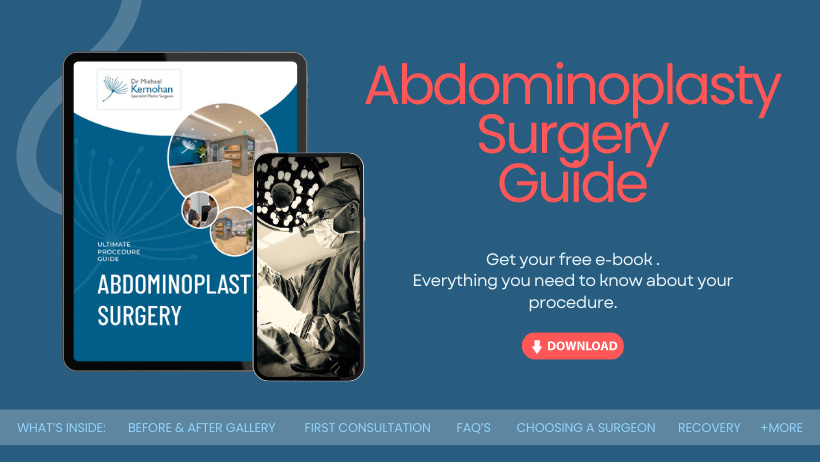Medicare Cover for Fleur De Lis Surgery
Navigating the complexities of healthcare coverage can often be confusing, particularly when it comes to specialised surgical procedures such as Fleur de Lis (Abdominoplasty) surgery. In Australia, Medicare plays a central role in providing access to necessary medical treatments, but understanding what is covered, especially for specific surgeries, requires a clear breakdown of information.
In this blog, Sydney Specialist Plastic Surgeon Dr Michael Kernohan offers an in-depth exploration of Medicare’s coverage for Fleur de Lis surgery.
Take the Quiz
Medicare’s Role in Healthcare
Medicare, Australia’s public health insurance system, is designed to ensure that all citizens and most permanent residents have access to a wide range of health and hospital services at little or no cost. Funded by the government, it covers many healthcare costs, but the extent of its coverage varies depending on the specific medical procedure and the circumstances under which it is performed.
The system is built on the principle of providing a safety net for healthcare, ensuring that essential medical services are accessible to all. However, it is important to recognise that while Medicare covers many standard medical procedures and treatments, its coverage of surgeries, particularly specialised ones like Fleur de Lis, can be more complex and requires a deeper understanding of the specific policies and criteria involved.
Medicare and Fleur de Lis Surgery
The term “Fleur de Lis” is derived from the pattern of the incisions and removal of skin, resembling a stylised lily. Unlike standard abdominoplasty, which involves a horizontal incision along the lower abdomen, Fleur de Lis surgery includes an additional vertical incision. This allows for the removal of excess skin both vertically and horizontally, offering a more comprehensive reshaping of the abdomen.
The primary purpose of this surgery is to remove the excess skin and fat and to tighten the muscles of the abdominal wall. This is particularly beneficial for individuals who have undergone significant weight changes or women post-pregnancy. The procedure aims to create a firmer and smoother abdominal profile.
When it comes to Medicare coverage for Fleur de Lis surgery, it is essential to understand that not all cosmetic surgeries are covered. Medicare generally provides coverage for procedures deemed medically necessary. Therefore, for Fleur de Lis surgery to be covered, it must be established as a necessary procedure for the patient’s health, not merely for cosmetic reasons.
Criteria for Medicare Coverage
Understanding the criteria for Medicare coverage, especially for specialised surgeries like Fleur de Lis, is essential for patients considering this procedure. Medicare, as Australia’s universal healthcare system, provides coverage for a range of surgical procedures but with specific guidelines and requirements that must be met. This section outlines these criteria, with a particular focus on what is required for Fleur de Lis surgery coverage.
General Criteria for Surgery Coverage by Medicare
Medicare covers surgeries that are deemed medically necessary. This means the procedure must be essential for diagnosing or treating an illness, injury, condition, disease, or its symptoms and meet accepted standards of medicine. In the context of surgeries, this often includes procedures that alleviate or prevent physical pain, improve or maintain the patient’s functional abilities, or reduce the risk of severe health complications.
To determine if a surgery is medically necessary, Medicare considers factors like the patient’s medical history, the severity of symptoms, and the potential effectiveness of the surgery. The decision also depends on whether the procedure is considered a standard and effective treatment for the condition in question.
Specific Requirements for Fleur de Lis Surgery Coverage
When it comes to Fleur de Lis surgery, the requirements for Medicare coverage are more stringent, as this procedure is often perceived as cosmetic. However, it can be covered by Medicare if it is proven to be medically necessary. For instance, if a patient has undergone significant weight loss and is left with excess skin that causes physical discomfort, skin infections, or hampers daily activities, Fleur de Lis surgery might be deemed necessary.
The distinction between cosmetic and medically necessary is a key factor in Medicare’s decision. Cosmetic surgery, primarily performed to alter or enhance appearance, is not typically covered. In contrast, reconstructive surgery like Fleur de Lis, when performed to correct abnormalities caused by congenital defects, developmental abnormalities, trauma, infection, tumours, or disease, is more likely to be covered.
Documentation and Medical Necessity for Approval
For Medicare to approve coverage for Fleur de Lis surgery, thorough documentation is required. This documentation should ideally include:
- Detailed Medical Evaluation: A comprehensive assessment by a healthcare provider, documenting the physical symptoms caused by the excess skin, such as chronic skin infections, rashes, or other health issues
- Photographic Evidence: Visual documentation showing the extent of the excess skin and how it affects the body
- History of Weight Loss: A record of the patient’s weight loss journey, including any previous surgeries like bariatric surgery, to establish the cause of the excess skin
- Recommendation from a Specialist: A statement from your surgeon or specialist explaining why Fleur de Lis surgery is necessary for the patient’s health and well-being
- Previous Treatments: Documentation of any non-surgical treatments attempted to alleviate the issues caused by the excess skin, such as physical therapy or skin treatments, and their outcomes
Download Dr Kernohan’s Abdominoplasty Tummy Tuck Surgery Guide

Medicare Item Numbers Related to Abdominoplasty in Australia
In Australia, the Medicare Benefits Schedule (MBS) outlines specific item numbers for various medical procedures, including abdominoplasty. These item numbers are crucial for patients to understand, as they determine the eligibility for Medicare rebates.
List of Relevant Medicare Item Numbers
- Medicare Item Number 30179: This item number is used for a specific type of abdominoplasty procedure. It typically involves more complex surgical requirements than standard abdominoplasty
- Medicare Item Number 30177: This item number covers lipectomy and abdominoplasty procedures that are necessary due to significant weight loss. The criteria include the presence of skin conditions that have not improved with conventional treatment, interference of redundant skin and fat with daily activities, and weight stability for at least 6 months post-weight loss. It is a specific code that caters to post-bariatric surgery or similar substantial weight loss scenarios
- Medicare Item Number 30176: This item number might relate to specific types of abdominoplasty or lipectomy procedures, likely with particular medical indications
- Medicare Item Number 30166: This item number is associated with specific criteria such as removal of redundant abdominal skin and lipectomy, as a wedge excision, for functional problems following significant weight loss equivalent to at least 5 body mass index points and if there has been a stable weight for a period of at least 6 months prior to surgery
- Medicare Item Number 30175: This item number covers radical abdominoplasty with repair of rectus diastasis, excision of skin and subcutaneous tissue, and transposition of the umbilicus. It is specifically for patients who have an abdominal wall defect as a consequence of pregnancy. Conditions include a diastasis of at least 3cm, symptoms of pain or discomfort at the site, and failure to respond to non-surgical conservative treatment. The patient must not have been pregnant in the last 12 months. This code is applicable once per lifetime
For the most accurate and up-to-date information, it’s important to refer directly to the Medicare Benefits Schedule on the Australian Government’s Department of Health website. The MBS provides detailed descriptions, criteria, and guidelines for all item numbers.
The Costs of Fleur de Lis Surgery in Australia
The cost of Fleur de Lis surgery in Sydney, Australia can vary widely based on various factors. It’s important to note that these costs can be significantly higher if additional procedures are required or if there are unique complexities in a patient’s case.
Factors Affecting the Cost
Several factors can influence the total cost of Fleur de Lis surgery in Sydney, including:
- Surgeon’s Fees: This is often the most significant portion of the cost. Fees vary depending on your surgeon’s experience, expertise, and reputation. Surgeons who are highly specialised in body contouring and reconstructive surgeries might charge more, reflecting their expertise in the field
- Hospital Fees: The choice of hospital and the length of the stay post-surgery contribute substantially to the overall cost. Private hospitals may charge more, and longer stays due to complications or the need for intensive post-operative care will increase the total cost
- Anaesthetic Costs: Anaesthesia is a critical part of the surgery, and the costs will depend on the duration of the surgery and the anaesthetists fees
- Post-Operative Care: Aftercare is essential for a successful recovery. This includes follow-up visits, potential treatments for complications, and any necessary medications
- Additional Procedures: Sometimes, additional procedures like liposuction or further reconstructive work are performed in conjunction with Fleur de Lis surgery, which can increase the overall cost
Cost Comparison with Standard Abdominoplasty
When compared to standard abdominoplasty, Fleur de Lis surgery is often more expensive. This is primarily due to the complexity and extent of the procedure. While a standard abdominoplasty typically involves a single horizontal incision to remove excess skin and fat, Fleur de Lis surgery includes an additional vertical incision, which makes the procedure more intricate and time-consuming.
The increased operating time and the higher level of skill required for Fleur de Lis surgery contribute to its higher cost. Additionally, the post-operative care for Fleur de Lis surgery can be more extensive, adding to the overall expense.
Private Health Insurance for Fleur de Lis Surgery Coverage
Private health insurance policies vary greatly in terms of what they cover. Generally, these policies are designed to complement Medicare, offering additional coverage that can include private hospital fees, choice of surgeon, and possibly some of the ancillary costs associated with surgery.
For Fleur de Lis surgery, which is often more complex than standard abdominoplasty, it’s essential to check with your insurance provider about the specifics of your coverage. Some key points to consider include:
- Eligibility Criteria: Insurance providers may have specific criteria for Fleur de Lis surgery coverage, similar to Medicare, such as the surgery being deemed medically necessary and not purely for cosmetic reasons
- Level of Cover: Different levels of private health insurance offer varying degrees of coverage. Higher-level policies might cover a greater portion of the surgery costs, including hospital stay and your surgeon fees
- Waiting Periods: Some insurance policies have waiting periods for certain types of surgery, so it’s important to check if such periods apply to Fleur de Lis surgery under your policy
Differences in Coverage between Private Insurance and Medicare
Understanding the differences between what is covered by private health insurance and Medicare is crucial:
- Medicare: Typically covers a portion of your surgeon’s fees and hospital costs for procedures it deems medically necessary. However, it does not cover the full cost of private hospital stays or the entire surgeon’s fee
- Private Health Insurance: Depending on the policy, it can cover some or all of the costs not covered by Medicare, including part of your surgeon’s fee, anaesthetist’s fee, and hospital costs. The extent of this coverage varies based on the policy
FAQs about Medicare and Abdominoplasty

Does Medicare cover abdominoplasty procedures?
- Medicare covers medical procedures that are deemed medically necessary. For abdominoplasty, also known as a tummy tuck, coverage is usually provided when the surgery is required for medical reasons, such as after significant weight loss resulting in excess skin that causes health issues. Purely cosmetic procedures are generally not covered.
What are the criteria for abdominoplasty to be considered medically necessary by Medicare?
- For abdominoplasty to be classified as medically necessary, there usually needs to be evidence of health-related issues caused by excess skin. This can include chronic skin infections, rashes, or other complications that impact daily living and cannot be resolved through non-surgical means. A surgeon’s assessment and recommendation are crucial in this determination.
Can I use Medicare for a Fleur de Lis abdominoplasty?
- Medicare may cover Fleur de Lis abdominoplasty if it is deemed medically necessary. This procedure, which is more extensive than a standard abdominoplasty, is often needed after massive weight loss. As with other forms of abdominoplasty, coverage depends on the demonstration of medical need, such as excess skin causing functional impairments or health issues.
Are there specific Medicare item numbers related to abdominoplasty coverage?
- Yes, there are specific Medicare item numbers for different types of abdominoplasty procedures. These item numbers are used to categorise the procedures and determine eligibility for coverage.
Further Reading about Fleur De Lis and Abdominoplasty with Sydney Plastic Surgeon Dr Kernohan
- Read more about Reducing Bruising after Fleur De Lis Surgery
- Read more about Recovery after Tummy Tuck or Abdominoplasty
- Read more about Abdominoplasty Scar Treatment, Healing and Fading
- Read more about Wearing Compression Garments after Tummy Tuck- Abdominoplasty
- Read more about What is a Good Weight for Tummy Tuck/ Abdominoplasty?
- Read more about Medicare for Body Lift Surgery to Remove Excess Skin
- Read more about Tips for Recovery after Fleur De Lis Surgery
Medical References about Medicare and Abdominoplasty
- Abdominoplasty Medicare win for Mums! – Australian Society of Plastic Surgeons
- MBS Online – Australian Department of Health
- Plastic And Reconstructive Surgery Changes – General/Skin Items – MBS Online
- Medicare – Services Australia









